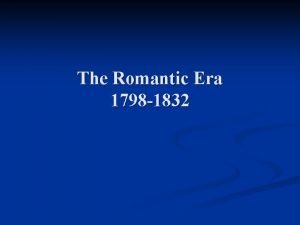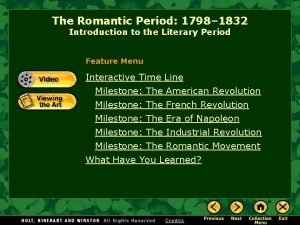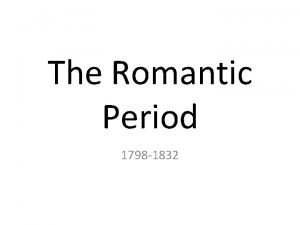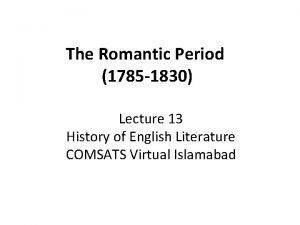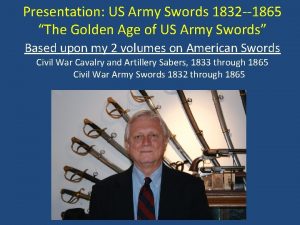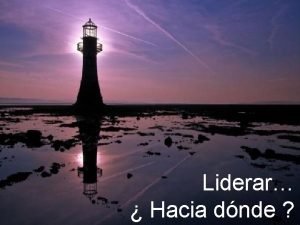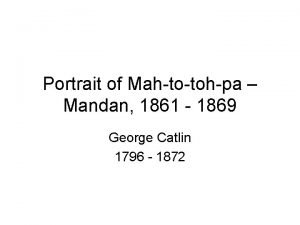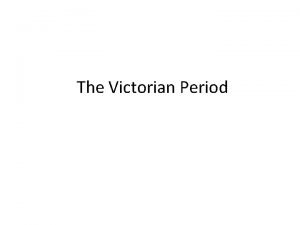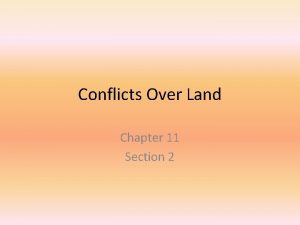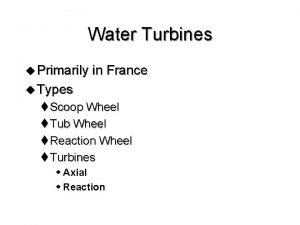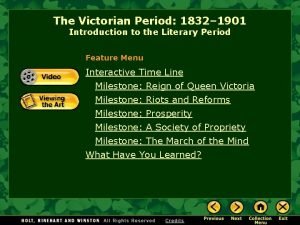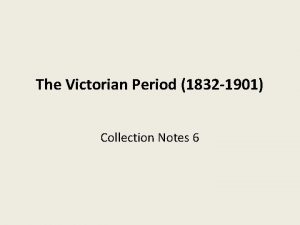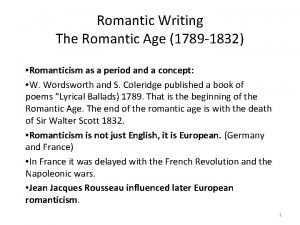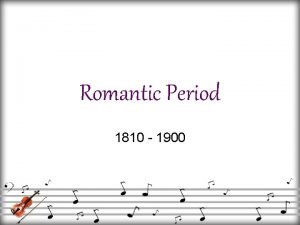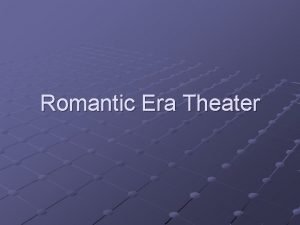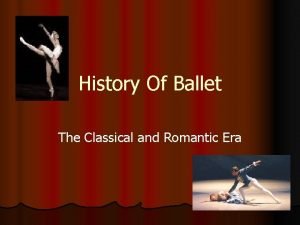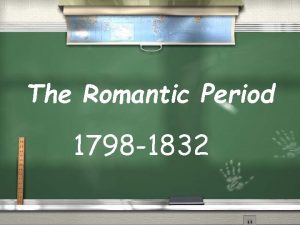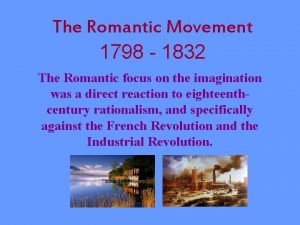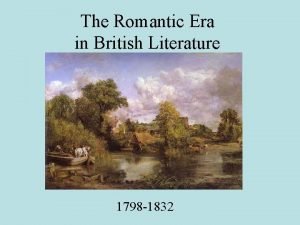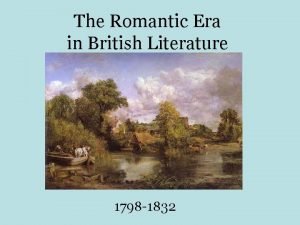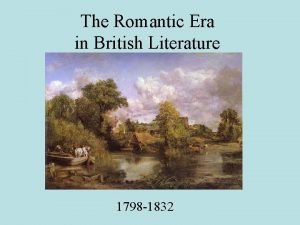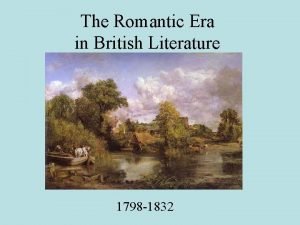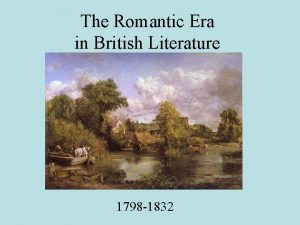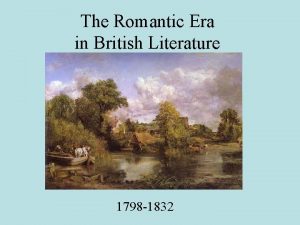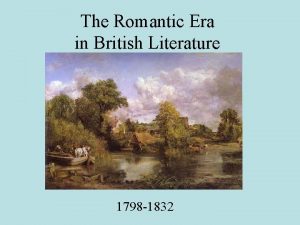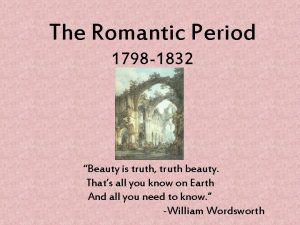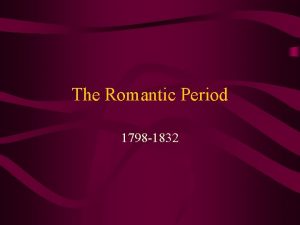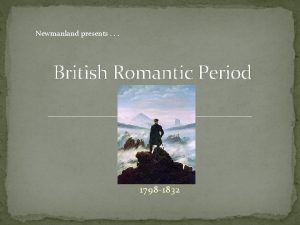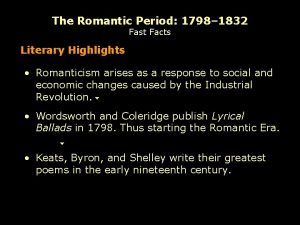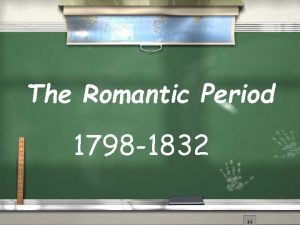The Romantic Era 1798 1832 I The Romantic























- Slides: 23

The Romantic Era 1798 -1832

I. The Romantic Period A. The era known as The Romantic Period began with the publication of The Lyrical Ballads. B. The Lyrical Ballads was a collection of poems by William Wordsworth and Samuel Taylor Coleridge. C. This era was dominated by six poets: Wordsworth, Coleridge, William Blake, Percy Blysse Shelley, John Keats, and Lord Byron (George Gordon).

II. Turbulent Times, Bitter Realities A. England is shifting from agricultural society to an industrial nation. B. Rise in working class concentrated in large cities dominated by factories. C. Most important political event of the period is the French Revolution.

II. Turbulent Times, Bitter Realities D. The American Revolution (1776) was a great economic loss for England. E. The French Revolution, however, had more of a political impact. 1. Involved the violent overthrow of an anointed king in favor of democracy. 2. Early attitudes toward French Revolution caused excitement among Romantic poets, who viewed this as the triumph of the common man. 3. Disillusionment set in as the Reign of Terror began with the execution of hundreds of French aristocrats.

III. The Industrial Revolution A. Rise in demand for factory labor leads to increase in city populations. 1. Lower classes forced to live in tenements. 2. Communal land once shared by small farmers taken over by individual owners and turned into private parks.

III. The Industrial Revolution B. Economic policy responsible for problems was laissez-faire. 1. Economic forces allowed to operate without government interference. 2. Rich grew richer, poor grew poorer. 3. Small children forced to work in factories.

IV. The Romantic Movement A. Grew out of frustration with conditions caused by Industrial Revolution. B. Formal, public style favored by Augustans of eighteenth century abandoned.

IV. The Romantic Movement C. Introduction of lyric poetry. 1. Imagination, not reason, was best response to create change. 2. Explored the more psychological and mysterious aspects of human experience. 3. Fascination with youth and innocence 4. Expressed need to question tradition and authority.

V. Romantic Poetry A. In the Preface to Lyrical Ballads, Wordsworth sought to give new direction to poetry. 1. Defined poetry as “the spontaneous overflow of powerful feelings. ” 2. Focus shifted from urban life to rural life, how man is affected by nature.

V. Romantic Poetry B. Romantic poets often called nature poets. 1. Prized experiences of beauty and majesty of nature. 2. Held a strong sense of the mysterious forces of nature. 3. Intrigued by the way nature and the human mind acted upon one another. 4. Wordsworth contended that the mind of man was a mirror of the most interesting elements of nature.

V. Romantic Poetry C. Wordsworth considered the poet “a man speaking to men. ” 1. “Speaking” refers to the kind of speaking: praise, confession, complaining, worship. 2. Lyric poetry is the true voice of feeling, or language of the heart. 3. The speaker is an ordinary person (reflection of democratic ideals) 4. The poet is endowed with a “more comprehensive soul” than the common man.

V. Romantic Poetry D. Other poets’ views of the role of the poet 1. William Blake believed the poet to be “the bard”, a divinely inspired revealer and teacher. 2. Coleridge wrote that the poet “brings the soul of man into activity” by employing “that synthetic and magical power…the imagination. ” 3. Keats felt the poet was “a physician” who “pours out a balm upon the world”

VI. The Gothic Novel A. Genre that centers around the eerie and supernatural; response to rational enlightenment of Restoration period. B. First gothic work is Walpole’s The Castle of Otranto 1. Presence of ghosts, living statues, eerie forest cave 2. Deals with the collapse of a royal family

The Art of the Romantic Period

Like the literature of its time, the art of the Romantic Period focused on the “sublime”, the dark, mysterious, and unknowable qualities of nature and of man. “Chiaroscuro”, also called claire-obscure, was the use of light and shadow in such a way as to create a sense of the awe and majesty of nature.

During the French Revolution, Jacques-Louis David played an active role both artistically and politically. He reorganized the Académe and produced numerous and spectacular propaganda exercises and was an avid supporter of Robespierre, who voted for the execution of the king. Jacques-Louis David “The Assassination of Marat”

Jacques-Louis David “The Lictors Bring to Brutus the Bodies of His Sons”

John Constable rejected the formal or "picturesque" depiction of nature found in the works of artists of his time. Instead, he tried to capture in a less formal way the effects of changing light and the patterns of clouds moving across the country sky. He loved the countryside, and his best work was of outdoor scenes in Suffolk and Hampstead. John Constable “The Haywain”

The later style of Joseph Mallard William Turner was an expression of the destructiveness of nature, particularly in some of his sea pieces. The force of wind and water was conveyed by his uniquely strong brushwork. Joseph Mallard William Turner “Ulysses Deriding Polyphemus”

Eugene Delacroix is considered by many to be the founder of the nineteenth century French style of art. His subject matter was usually tragic and bloody. “He was not popular because the multitude wants pleasure, and Delacroix, like Pascal, does not make one laugh; he terrifies” (New Advent). Eugene Delacroix “Liberty Leading the People”

Eugene Delacroix “The Sea of Galilee”

William Blake began as an engraver, then became renowned for his poetry, including the Songs of Innocence and Songs of Experience. “Newton”

“The Great Red Dragon and the Woman Clothed With the Sun”
 The romantic period 1798 to 1832 summary
The romantic period 1798 to 1832 summary Romantic period 1798 to 1832
Romantic period 1798 to 1832 The era of change 1798-1832
The era of change 1798-1832 Romantic period 1798 to 1832
Romantic period 1798 to 1832 The romantic period 1798 to 1832
The romantic period 1798 to 1832 The romantic period 1785 to 1832
The romantic period 1785 to 1832 The romantic age (1798 to 1824)
The romantic age (1798 to 1824) Model 1832 dragoon saber
Model 1832 dragoon saber гмайл
гмайл Sans arc lakota
Sans arc lakota George catlin self portrait
George catlin self portrait Ceremoniality
Ceremoniality In 1832 the sauk chieftain
In 1832 the sauk chieftain 1832
1832 The victorian period (1832–1901)
The victorian period (1832–1901) The victorian period (1832–1901)
The victorian period (1832–1901) Victorian age 1832 to 1901
Victorian age 1832 to 1901 Bolton romanticism amp; politics 1789 1832 download
Bolton romanticism amp; politics 1789 1832 download Romantic archestra
Romantic archestra American literature romanticism
American literature romanticism Wagner romantic period
Wagner romantic period Romantic time period
Romantic time period Romantic era plays
Romantic era plays Characteristics of romantic ballets
Characteristics of romantic ballets
